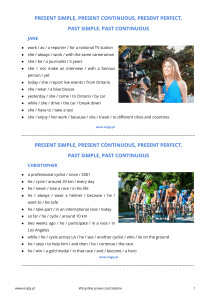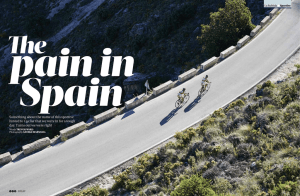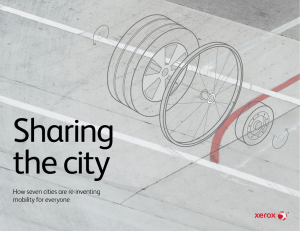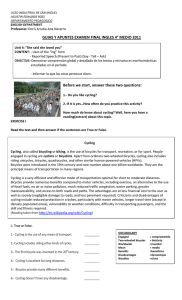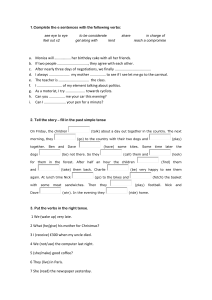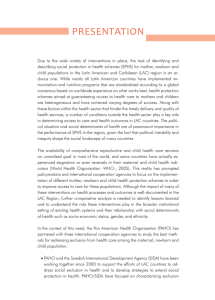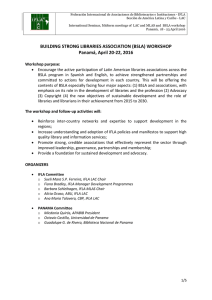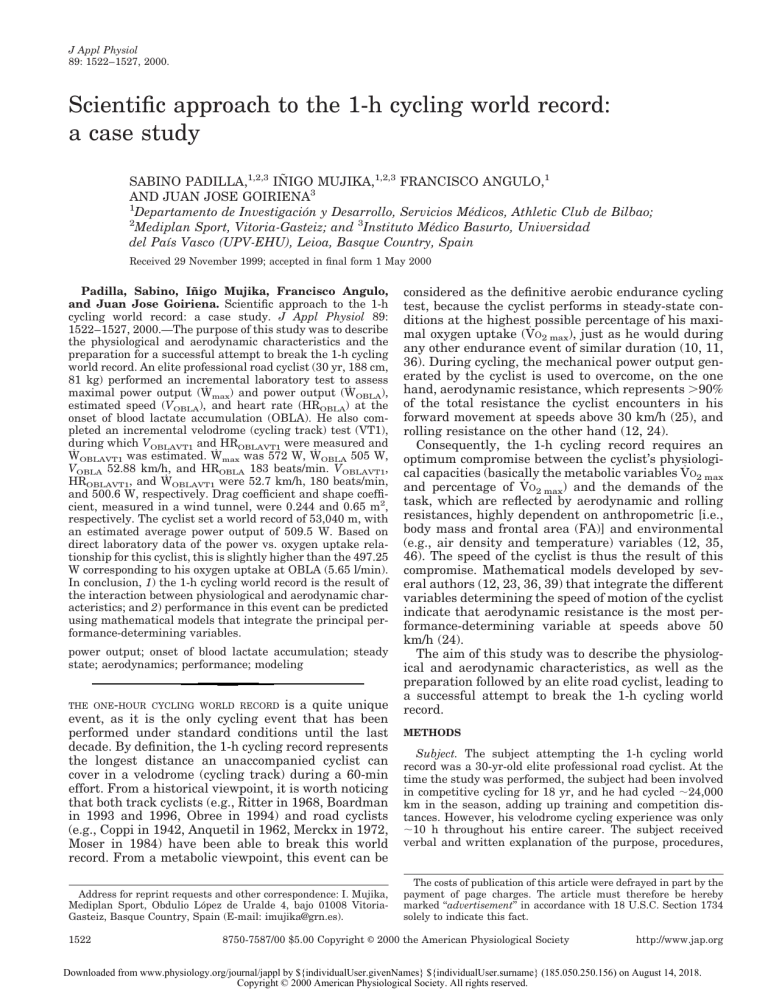
J Appl Physiol 89: 1522–1527, 2000. Scientific approach to the 1-h cycling world record: a case study SABINO PADILLA,1,2,3 IÑIGO MUJIKA,1,2,3 FRANCISCO ANGULO,1 AND JUAN JOSE GOIRIENA3 1 Departamento de Investigación y Desarrollo, Servicios Médicos, Athletic Club de Bilbao; 2 Mediplan Sport, Vitoria-Gasteiz; and 3Instituto Médico Basurto, Universidad del Paı́s Vasco (UPV-EHU), Leioa, Basque Country, Spain Received 29 November 1999; accepted in final form 1 May 2000 Padilla, Sabino, Iñigo Mujika, Francisco Angulo, and Juan Jose Goiriena. Scientific approach to the 1-h cycling world record: a case study. J Appl Physiol 89: 1522–1527, 2000.—The purpose of this study was to describe the physiological and aerodynamic characteristics and the preparation for a successful attempt to break the 1-h cycling world record. An elite professional road cyclist (30 yr, 188 cm, 81 kg) performed an incremental laboratory test to assess maximal power output (Ẇmax) and power output (ẆOBLA), estimated speed (VOBLA), and heart rate (HROBLA) at the onset of blood lactate accumulation (OBLA). He also completed an incremental velodrome (cycling track) test (VT1), during which VOBLAVT1 and HROBLAVT1 were measured and ẆOBLAVT1 was estimated. Ẇmax was 572 W, ẆOBLA 505 W, VOBLA 52.88 km/h, and HROBLA 183 beats/min. VOBLAVT1, HROBLAVT1, and ẆOBLAVT1 were 52.7 km/h, 180 beats/min, and 500.6 W, respectively. Drag coefficient and shape coefficient, measured in a wind tunnel, were 0.244 and 0.65 m2, respectively. The cyclist set a world record of 53,040 m, with an estimated average power output of 509.5 W. Based on direct laboratory data of the power vs. oxygen uptake relationship for this cyclist, this is slightly higher than the 497.25 W corresponding to his oxygen uptake at OBLA (5.65 l/min). In conclusion, 1) the 1-h cycling world record is the result of the interaction between physiological and aerodynamic characteristics; and 2) performance in this event can be predicted using mathematical models that integrate the principal performance-determining variables. power output; onset of blood lactate accumulation; steady state; aerodynamics; performance; modeling THE ONE-HOUR CYCLING WORLD RECORD is a quite unique event, as it is the only cycling event that has been performed under standard conditions until the last decade. By definition, the 1-h cycling record represents the longest distance an unaccompanied cyclist can cover in a velodrome (cycling track) during a 60-min effort. From a historical viewpoint, it is worth noticing that both track cyclists (e.g., Ritter in 1968, Boardman in 1993 and 1996, Obree in 1994) and road cyclists (e.g., Coppi in 1942, Anquetil in 1962, Merckx in 1972, Moser in 1984) have been able to break this world record. From a metabolic viewpoint, this event can be Address for reprint requests and other correspondence: I. Mujika, Mediplan Sport, Obdulio López de Uralde 4, bajo 01008 VitoriaGasteiz, Basque Country, Spain (E-mail: [email protected]). 1522 considered as the definitive aerobic endurance cycling test, because the cyclist performs in steady-state conditions at the highest possible percentage of his maximal oxygen uptake (V̇O2 max), just as he would during any other endurance event of similar duration (10, 11, 36). During cycling, the mechanical power output generated by the cyclist is used to overcome, on the one hand, aerodynamic resistance, which represents ⬎90% of the total resistance the cyclist encounters in his forward movement at speeds above 30 km/h (25), and rolling resistance on the other hand (12, 24). Consequently, the 1-h cycling record requires an optimum compromise between the cyclist’s physiological capacities (basically the metabolic variables V̇O2 max and percentage of V̇O2 max) and the demands of the task, which are reflected by aerodynamic and rolling resistances, highly dependent on anthropometric [i.e., body mass and frontal area (FA)] and environmental (e.g., air density and temperature) variables (12, 35, 46). The speed of the cyclist is thus the result of this compromise. Mathematical models developed by several authors (12, 23, 36, 39) that integrate the different variables determining the speed of motion of the cyclist indicate that aerodynamic resistance is the most performance-determining variable at speeds above 50 km/h (24). The aim of this study was to describe the physiological and aerodynamic characteristics, as well as the preparation followed by an elite road cyclist, leading to a successful attempt to break the 1-h cycling world record. METHODS Subject. The subject attempting the 1-h cycling world record was a 30-yr-old elite professional road cyclist. At the time the study was performed, the subject had been involved in competitive cycling for 18 yr, and he had cycled ⬃24,000 km in the season, adding up training and competition distances. However, his velodrome cycling experience was only ⬃10 h throughout his entire career. The subject received verbal and written explanation of the purpose, procedures, The costs of publication of this article were defrayed in part by the payment of page charges. The article must therefore be hereby marked ‘‘advertisement’’ in accordance with 18 U.S.C. Section 1734 solely to indicate this fact. 8750-7587/00 $5.00 Copyright © 2000 the American Physiological Society http://www.jap.org Downloaded from www.physiology.org/journal/jappl by ${individualUser.givenNames} ${individualUser.surname} (185.050.250.156) on August 14, 2018. Copyright © 2000 American Physiological Society. All rights reserved. 1523 ONE-HOUR CYCLING RECORD Fig. 1. Overview of the cyclist’s preparation for the 1-h cycling world record. LT, laboratory test; VT1, VT2, VT3, and VT4, velodrome tests 1, 2, 3, and 4, respectively; WRA, world record attempt. and potential risks of the study before giving written, informed consent to participate. All experimental procedures were approved by the Ethics Committee of the Universidad del Paı́s Vasco. Anthropometric variables. The cyclist’s body surface area (BSA, in m2) was estimated from body mass and height, using the equation of Du Bois and Du Bois (13) BSA ⫽ 0.007184 ⫻ BM 0.425 ⫻ H 0.725 in which BM is the cyclist’s body mass (in kg) and H is his height (in cm). The frontal area (FA) of the cyclist and his bicycle was estimated as follows (4, 45): photographs of the cyclist in riding position and of a reference rectangle of known area are taken. The contour of the ensemble cyclist-bicycle and that of the rectangle are then cut out and weighed. The subject’s FA is estimated by comparing the masses of the pictures of the ensemble cyclist-bicycle and that of the reference area. Laboratory testing. Nineteen days before his world record attempt (Fig. 1), the subject performed an incremental maximal laboratory test on a mechanically braked cycle ergometer (Monark 818 E, Varberg, Sweden), which was adapted with a racing saddle, drop handlebars, and clip-in pedals. Initial workload was set at 110 W and was increased by 35 W every 4 min, with 1-min recovery intervals between workloads. Keeping cadence with a metronome, pedal rate was kept constant at 75 rpm through the entire test. Testing continued until the subject could no longer maintain the required pedal rate. Heart rate (HR) was recorded every 5 s throughout the test (Sport Tester PE 3000, Polar Electro Oy, Kempele, Finland). Blood samples were obtained to determine blood lactate concentration ([Lac]) immediately after each workload was completed. [Lac] values attained during the last workload were considered to be maximal (37). Maximal power output (Ẇmax) was determined as the highest workload the cyclist maintained for a complete 4-min period. Following the recommendation of the manufacturer, 9% was added to this value in the final computation of Ẇmax, due to the friction in the transmission system of Monark cycle ergometers (1). The exercise intensity corresponding to the onset of blood lactate accumulation (OBLA) was identified on the [Lac]power output curve by straight-line interpolation between the two closest points as the power output eliciting a [Lac] of 4 mmol/l (41). Power output and HR values at OBLA (ẆOBLA and HROBLA, respectively) were determined by straight-line interpolation. Oxygen uptake (V̇O2) was not measured in this laboratory test to avoid any possible interference of gas-analyzing equipment with the subject’s cycling performance. However, previous laboratory tests using an identical protocol elicited a V̇O2 max of 6.4 l/min, a V̇O2 at OBLA of 5.65 l/min, and a mean true efficiency (28) of 26%. Velodrome testing. The subject performed four velodrome tests before his world record attempt (Fig. 1). The first test (VT1) was an incremental maximal test performed in an indoor 285-m track situated at sea level. Testing consisted of 2,850-m (10-lap) workloads, interspersed with 1-min recovery periods. At each workload, the subject progressively reached the target speed during the first 2 laps, then maintained it during the remaining 8 laps. Initial speed was 31.2 km/h, and it was increased by 2.6 km/h after each workload until exhaustion. The cyclist selected his preferred gear ratio at each riding speed. VT1 was performed using a time trial road racing bicycle (Pinarello, Treviso, Italy). The weight of the bicycle was 9.0 kg; the diameter of the front and rear wheels was 0.7 m. The front wheel had 19 flat spokes, and the back wheel had four carbon fiber spokes. The tubeless tires (Vittoria, Bergamo, Italy) were inflated at a pressure of 6.0 kg/cm2. The gear ratio ranged from 55 ⫻ 18 to 55 ⫻ 11 and the pedal rate from 70 to 112 rpm. The subsequent velodrome tests (VT2, VT3, and VT4) were performed in the same indoor 250-m track where the world record was to be attempted, also at sea level. VT2 consisted of five repetitions of 5,250 m (21 laps), interspersed with 6-min recovery periods. VT3 consisted of four repetitions of 9,000 m (36 laps), with 8 min recovery between repetitions. During VT4, the subject performed two repetitions of 16,000 m (64 laps), recovering for 10 min between repetitions. During VT2, VT3, and VT4, the cyclist rode the bicycle and wore the aerodynamically designed suit (85% Coolmax, 15% elastane, Nalini Sport, Vicenza, Italy) and helmet (Ruddy Project, Treviso, Italy) with which he would attempt the world record. The total weight of the bicycle was 7.280 kg. Front and rear disk wheels (Campagnolo, Vicenza, Italy) were made of Kevlar, the diameters being 66 cm for the former and 71.2 cm for the latter. The front and rear tubeless tires were 19 and 20 mm wide, respectively; they were made of silk and inflated at a pressure of 6.0 kg/cm2 (Vittoria, Bergamo, Italy). The crank arm’s length was 180 mm. During all velodrome tests, the subject’s bicycle was equipped with a handlebar microcomputer for speed, pedal rate, and HR monitoring (Polar Cyclovantage, Polar Electro Oy). In VT1, steady-state HR values were determined as the mean value of the last min of each workload. In VT2, VT3, and VT4, average HR and speed attained during the last 3, 4 and 6 min of each repetition, respectively, were computed. Blood samples were obtained after each workload or repetition for [Lac] determination. After VT1, speed and HR values at OBLA (VOBLAVT1 and HROBLAVT1, respectively) were determined by straight-line interpolation on the [Lac]-speed curve. Wind tunnel testing. Wind tunnel testing (Augusta Helicopter, Milano, Italy) was carried out to determine the drag coefficient (Cx), which has been proposed as a measure of aerodynamic efficiency. It has also been suggested that the size of an object is of major importance for aerodynamic efficiency, as it determines the FA of moving objects (15, 22). These two variables are integrated in the following equation C x ⫽ FA ⫻ C d in which Cx and FA are in m2, and Cd is the shape coefficient (in m2). Testing was performed at a speed of 50 km/h, with an air temperature of 20.4°C, an air pressure of 1,000 mbar, and an air density of 1.186151 kg/m3. The precision of the force measurement system in terms of speed is on the order of 0.05 km/h for each point of drag (1 point corresponding to a Cx of 0.001 m2). From the measurement point of view, this corresponds to a drag force of 12 g at 50 km/h. Downloaded from www.physiology.org/journal/jappl by ${individualUser.givenNames} ${individualUser.surname} (185.050.250.156) on August 14, 2018. Copyright © 2000 American Physiological Society. All rights reserved. 1524 ONE-HOUR CYCLING RECORD Table 1. Speed, heart rate, and blood lactate concentration values during the different velodrome tests performed by the subject Velodrome Test VT2 Repetition Repetition Repetition Repetition Repetition VT3 Repetition Repetition Repetition Repetition VT4 Repetition Repetition Speed, km/h HR, beats/min [Lac], mmol/l 1 2 3 4 5 53.3 ⫾ 0.5 53.0 ⫾ 0.5 53.2 ⫾ 0.6 53.3 ⫾ 0.5 53.6 ⫾ 0.7 180 ⫾ 1 183 ⫾ 1 189 ⫾ 1 191 ⫾ 2 196 ⫾ 1 6.1 5.1 5.3 6.7 7.7 1 2 3 4 53.1 ⫾ 0.3 53.0 ⫾ 0.5 53.4 ⫾ 0.5 54.2 ⫾ 0.5 182 ⫾ 3 186 ⫾ 1 184 ⫾ 2 194 ⫾ 1 7.5 5.4 3.0 5.3 1 2 53.0 ⫾ 0.3 53.0 ⫾ 0.3 182 ⫾ 2 186 ⫾ 1 4.5 4.5 Speed and heart rate (HR) values are means ⫾ SD recorded during the final 3, 4, and 6 min, respectively, during velodrome tests VT2, VT3, and VT4. VT2, 5 ⫻ 5,250 m with 6 min recovery; VT3, 5 ⫻ 9,000 m with 8 min recovery; VT4, 2 ⫻ 16,000 m with 10 min recovery. [Lac], blood lactate concentration. Estimation of cycling power output. Power output during cycling was estimated by means of the following equation (31) Ẇ T ⫽ FA ⫻ C d ⫻ 共/2兲 ⫻ V ⫹ 共C R ⫻ M ⫻ g ⫻ V兲 3 in which ẆT is power output (in W), FA is in m2, Cd is in m2, is air density (1.225 kg/m3 at sea level), V is the speed of movement (in m/s), CR is the rolling resistance coefficient [0.0025 (30, 32)], M is the mass of the cyclist and his bicycle (in kg), and g is gravity (9.81 m/s2). Blood lactate. During both laboratory and velodrome testing protocols, capillary blood samples (25 l) were withdrawn from a previously hyperemized earlobe (Finalgon, Laboratorios FHER, Barcelona, Spain) during the first seconds of recovery after each workload or repetition. As well, blood samples were obtained 3 and 5 min after the world record attempt (3). [Lac] was immediately determined by using an electroenzymatic method with an automatic analyzer (YSI 1500 Sport, Yellow Springs Instruments, Yellow Springs, OH), which was calibrated with standard solutions of known [Lac] (0, 5, and 15 mmol/l) as recommended by the manufacturer. and 180 beats/min. Power output at OBLA during VT1 (ẆOBLAVT1), estimated from VOBLAVT1, was 500.6 W. Peak [Lac] at the end of VT1 was 8.5 mmol/l. Table 1 shows average speed and HR values of the final 3, 4, and 6 min of each repetition performed by the subject during VT2, VT3, and VT4, respectively, as well as [Lac] values after each repetition. Wind tunnel data. Considering the above-mentioned FA value of 0.3755 m2, the subject’s Cx measured in the wind tunnel was 0.244 m2, and his Cd was 0.65 m2. World record attempt data. The successful world record attempt took place 4 days after VT4 (Fig. 1) at 3:00 PM, in a 250-m velodrome situated at sea level. Ambient temperature was 20°C, and relative humidity was 75%. The cyclist covered 53.040 km, 327 m more than the previous world record. The speed maintained by the cyclist lap by lap is shown in Fig. 2. Average mechanical power output estimated from the average record speed was 509.53 W. The gear ratio used by the cyclist during the record ride was 59 ⫻ 14 (8.77 m), and the average pedal rate was 101 rpm. At 3 and 5 min after the completion of the world record, [Lac] was 5.2 and 5.1 mmol/l, respectively. DISCUSSION As can be seen in Table 2, the anthropometric characteristics of the cyclist (188 cm, 81 kg) were different from those of Merckx (184 cm, 72 kg) and Moser (182 cm, 76 kg), who broke the world record in the past, but even more different from recent world record holders like Rominger (175 cm, 65 kg) and Boardman (177 cm, 69 kg). The morphotype of the latter two cyclists confers them relatively small FA values of 0.3220 and 0.3342 m2, respectively. These result in very low Cx values, which could explain to a great extent the elevated record speeds attained by these cyclists, i.e., 55.291 km/h by Rominger and 56.375 km/h by Board- RESULTS Anthropometric variables. The cyclist’s height and body mass were 188 cm and 81 kg, respectively. His estimated BSA was 2.0713 m2, and the FA of the cyclist and his bicycle was 0.3755 m2. Laboratory data. The subject’s laboratory Ẇmax was 572 W, whereas his ẆOBLA attained 505 W. His HRmax and HROBLA were 195 and 183 beats/min, respectively. Speed corresponding to the OBLA exercise intensity during the laboratory test (VOBLA), estimated from ẆOBLA, was 52.88 km/h. Maximal [Lac] in this test was 7.4 mmol/l. Velodrome data. During VT1, the subject was able to perform nine workloads, attaining a final steady-state speed of 54.6 km/h, with a peak HR of 190 beats/min. VOBLAVT1 and HROBLAVT1 were, respectively, 52.7 km/h Fig. 2. Actual (lap-by-lap) and average speed of the cyclist during the 1-h cycling world record performance. Downloaded from www.physiology.org/journal/jappl by ${individualUser.givenNames} ${individualUser.surname} (185.050.250.156) on August 14, 2018. Copyright © 2000 American Physiological Society. All rights reserved. 1525 ONE-HOUR CYCLING RECORD Table 2. Characteristics of recent 1-h cycling world record holders Cyclist Record, km/h Date, mo/day/yr Height, cm Mass, kg BSA, m2 FA, m2 Cd, m2 CX , m2 Power, W Merckx Moser Obree Indurain Rominger Boardman 49.432 51.151 52.713 53.040 55.291 56.375 10/25/72 01/21/84 04/27/94 09/02/94 11/05/94 09/06/96 184 182 182 188 175 177 72 76 71 81 65 69 1.940 1.969 1.912 2.076 1.791 1.857 0.3491 0.3544 0.3441 0.3755 0.3220 0.3342 0.75 0.70 0.50 0.65 0.60 0.55 0.2618 0.2481 0.1720 0.2441 0.1932 0.1838 380 400 359 510 456 462 BSA, body surface area, estimated using the equation of Du Bois and Du Bois (13); FA, frontal area, considering it as a constant 18% fraction of BSA (12, 36, 46); Cd, shape coefficient, estimated from values of the literature for different riding positions and equipment (4, 5, 10, 22, 32, 33, 36); Cx, drag coefficient, measured for Moser (9) and Indurain, and estimated from FA and Cd for the rest of the cyclists; Power, mechanical power output during the record ride, estimated with the model of Menard (31). man. Indeed, aerodynamic efficiency is a performancedetermining variable at speeds above 50 km/h (15, 25). The FA value of the subject in this study (0.3755 m2) represents 18.1% of his BSA, which agrees with previous reports that consider FA to be a constant fraction of BSA (12). The present values are also in keeping with those observed by Swain et al. (45) for riders with similar physical characteristics (0.378 m2 and 17.8% of BSA), but slightly lower than values reported by Capelli et al. [0.393 m2 and 20% (4) and 0.42 m2 and 22% (5)] and Sjøgaard et al. [25% of BSA (43)]. The validity of the OBLA intensity determined during an incremental test as a predictor of the maximal steady-state intensity sustainable during prolonged exercise for all individuals has been questioned. Several authors have reported steady-state conditions at exercise intensities eliciting blood lactate values different from the fixed 4 mmol/l value corresponding to OBLA (14, 44). However, this exercise intensity was chosen because it has also been reported that it is the highest possible steady-state work intensity that can be maintained for a prolonged period of time and has therefore been considered an excellent endurance index (41, 42, 44, 47). This fully agrees with the metabolic description of the 1-h cycling record given in the introduction. Therefore, and given that VOBLA estimated from laboratory power measurements (52.88 km/h) and VOBLAVT1 (52.7 km/h) were very close to the world record set by Obree (52.713 km), it was decided that the subject could make a world record attempt. The slight difference between VOBLA and VOBLAVT1 could be due to the different methodology used in both progressive protocols (estimation vs. measurement, and constant time vs. constant distance) and/or the intrasubject variability (18). In addition to the above, the subject’s OBLA intensity was 88.2% of his maximal aerobic power, similar to the 87.7% (27) and 87.9% (42) values previously reported for endurance runners or the 88.7% (7) and 89.7% (8) values reported during steady-state prolonged cycling for elite cyclists. These observations led us to 1) set a target record speed of 53.0 km/h, which was determined by taking into consideration the standing record on the one hand and the cyclist’s VOBLA and VOBLAVT1 on the other hand; and 2) perform several velodrome tests to evaluate whether the subject could maintain such a speed under steady-state conditions. This was done by measuring speed, HR, and [Lac] during VT2, VT3, and VT4. As can be seen in Table 1, the first repetition of VT2 and VT3 elicited higher HR and [Lac] values than those expected from the incremental tests and those measured during subsequent repetitions. This could be attributed to the speed, which was higher than VOBLA and VOBLAVT1, and to the “early lactate” phenomenon (6, 40), given that the duration of the repetitions was relatively short (between 6 and 10 min) and the target riding speed was attained in 15–17 s. As a matter of fact, these elevated HR and [Lac] values were not observed during the first repetition of VT4, performed at a speed closer to VOBLA and VOBLAVT1 (53.0 km/h) and of longer duration (18 min). In addition, a drift in HR and [Lac] values can be observed during VT2, most probably due to an increase in speed between repetitions 2 and 5 and to the fact that, only during VT2, the subject started each repetition from a still position. This could have induced an accumulated oxygen deficit over the five repetitions (30). Thereafter, the target speed during VT3 and VT4 was attained drafting behind a motorcycle, and the HR and [Lac] drift was thus avoided (Table 1). Only in the fourth repetition of VT3 were these values increased, as a result of a significantly higher riding speed (54.2 km/h). Despite this increased speed, neither HR nor [Lac] reached the values attained during the last repetition of VT2. This seemed to confirm the negative influence of initiating the effort from a still position. During both repetitions of VT4, speed was kept constant, and HR and [Lac] values were stable and very close to the values predicted from laboratory measurements. Nevertheless, there was a slight cardiovascular drift between repetitions 1 and 2, which has also been observed by other authors for exercise intensities similar to that maintained by the subject (19, 21, 34). In the present case, this drift could have been induced by a slight hyperthermia (16) because the tests were performed in an indoor velodrome, at an ambient temperature of 22°C and relative humidity of 70%, and/or a by state of mild dehydration because the subject had been exercising for ⬃50 min (17). In any case, the observed drift was not due to nondetected speed increments, because the measurement system used during the tests Downloaded from www.physiology.org/journal/jappl by ${individualUser.givenNames} ${individualUser.surname} (185.050.250.156) on August 14, 2018. Copyright © 2000 American Physiological Society. All rights reserved. 1526 ONE-HOUR CYCLING RECORD is quite reliable (26) and manual timing was simultaneously performed. The Cx value determined for the subject in the wind tunnel (0.244 m2) was similar to that reported by Dal Monte et al. (9) for Moser (0.246 m2) and that observed by Menard (31) for professional cyclists (0.250 m2). On the other hand, it was much higher than the values for Obree (0.1720 m2), Boardman (0.1838 m2), or Rominger (0.1932 m2), estimated from their anthropometric characteristics and Cd values during their record rides (Table 2). These estimated values were not very different from those previously attributed (Menard, personal communication, 34) to Obree (0.1800 m2), Boardman (0.207 m2), and Rominger (0.2017 m2). The subject’s Cd (0.65 m2) was in keeping with the values of 0.654 and 0.660 m2 recently reported for road cyclists (4, 5) and 0.592 m2 for indoor cyclists (36). All these values were much lower than those of 0.75, 0.80, and 0.83 m2, respectively described by di Prampero (10), Kyle (22), and Gross et al. (15) for cyclists using nonaerodynamically designed equipment and riding in less aerodynamically efficient positions. Indeed, several authors have reported lowered aerodynamic resistance induced by equipment and position changes that reduce FA and/or Cd and, therefore, Cx (24, 25, 29, 31, 33). Although the subject’s Cd could be considered as good, the Cx measured in the wind tunnel was quite high due to his big body size, which determines a much higher FA than that of recent world record holders and contributes to a relatively poor aerodynamic efficiency. In fact, considering FA as a constant 18% fraction of BSA (12), which was the case of the present subject, the estimated FA values of other record holders were much lower (Table 2). All of the above indicate that the subject could only be successful in breaking the world record by riding with a much higher power output and a much higher V̇O2 than his competitors. As a matter of fact, the subject was able to cycle 53.040 km with an estimated average power output of 509.5 W, whereas Rominger and Boardman cycled, respectively, 4.24 and 6.29% further with 11.84 and 10.39% lower power outputs (Table 2). On the basis of direct laboratory data of the power vs. V̇O2 relationship for this cyclist, the power output for a V̇O2 at OBLA of 5.65 l/min is 497.25 W. This is slightly lower than the power output estimated from his record ride. The model used in this investigation to estimate cycling speed from mechanical power output or vice versa (31) takes the most important variables that determine a cyclist’s forward movement into consideration, in agreement with other cycling motion models published in the literature (5, 12, 24, 35, 36). Differences with the power output estimations recently published by Bassett et al. (2) may be related to the fact that important determinants of cycling speed such as FA, Cx, and Cd were precisely measured in this investigation, whereas the above-mentioned authors used estimations and assumptions that imply a greater possibility of error, including that bigger cyclists have a much smaller FA-to-BM ratio and that Cd is similar in all cyclists. This leads to underestimating the power output of bigger cyclists. Indeed, our power output estimations are similar to those of Bassett et al. for smaller cyclists but quite higher for bigger cyclists like the one under investigation. The 188-m difference in 1 h estimated from VOBLA and VOBLAVT1 was very close to the 160-m difference between VOBLA and the actual record distance covered by the cyclist. The interest of analyzing the relationship between laboratory and actual performance measurements has been recently discussed (18). The present results show the existence of a close relationship between those measurements for cycling. When standardized environmental and equipment conditions are maintained, adequate models that integrate all major performance-determining variables are used, and laboratory-based assumptions are verified in the field, cycling laboratory tests can have a high predictive value. Moreover, the performance and metabolic values obtained during the record ride corroborate the validity of OBLA as the intensity at which the subject was in a metabolic steady-state condition during the 1-h event, as indicated by the recovery in [Lac] values measured 3 and 5 min after the ride. In conclusion, the present results indicated that the 1-h cycling world record is an event in which there is a close interaction between, on the one hand, anthropometric characteristics (which determine Cx) and, on the other, metabolic capacity (evaluated in this study by means of Ẇmax and percentage of Ẇmax that can be maintained for a prolonged period of time), the record speed or cycled distance being the result of this interaction. Performance in this event is thus the outcome of and implies the need for scaling a cyclist’s physiological capacities, as previously suggested (20, 37, 38, 46). In addition, the present results show the validity of several mathematical models that integrate the main cycling performance-determining variables to predict velodrome cycling performance. We thank Miguel Indurain for effort and cooperation and Aldo Sassi for excellent assistance. This investigation was supported by a research grant from IBERDROLA. REFERENCES 1. Åstrand PO. Work Tests with the Bicycle Ergometer. Varberg, Sweden: Monark-Crescent, 1970. 2. Bassett DR Jr, Kyle CR, Passfield L, Broker JP, and Burke ER. Comparing cycling world hour records, 1967–1996: modeling with empirical data. Med Sci Sports Exerc 31: 1665–1676, 1999. 3. Bishop P and Martino M. Blood lactate measurement in recovery as an adjunct to training: practical considerations. Sports Med 16: 5–13, 1993. 4. Capelli C, Rosa G, Butti F, Ferretti G, Veicsteinas A, and di Prampero PE. Energy cost and efficiency of riding aerodynamic bicycles. Eur J Appl Physiol 67: 144–149, 1993. 5. Capelli C, Schena F, Zamparo P, Dal Monte A, Faina M, and di Prampero PE. Energetics of best performances in track cycling. Med Sci Sports Exerc 30: 614–624, 1998. 6. Cerretelli P, Pendergast DP, Paganelli WC, and Rennie DW. Effects of specific muscle training on V̇O2 response and early blood lactate. J Appl Physiol 47: 761–769, 1979. 7. Coyle EF, Coggan AR, Hopper MK, and Walters TJ. Determinants of endurance in well-trained cyclists. J Appl Physiol 64: 2622–2630, 1988. Downloaded from www.physiology.org/journal/jappl by ${individualUser.givenNames} ${individualUser.surname} (185.050.250.156) on August 14, 2018. Copyright © 2000 American Physiological Society. All rights reserved. ONE-HOUR CYCLING RECORD 8. Coyle EF, Feltner ME, Kautz SA, Hamilton MT, Montain SJ, Baylor AM, Abraham LD, and Petrek GW. Physiological and biomechanical factors associated with elite endurance cycling performance. Med Sci Sports Exerc 23: 93–107, 1991. 9. Dal Monte A, Menchinelli C, and Marini C. Una nuova bicicletta per l’alta prestazione e un disegno di ruote quale risultato di avanzati studi biomeccanici e tecnologici. Intl Conf Cycling Biomech San Sebastián, Spain 1992, Document 6, p. 1–15. 10. Di Prampero PE. The energy cost of human locomotion on land and in water. Int J Sports Med 7: 55–72, 1986. 11. Di Prampero PE, Capelli C, Pagliaro P, Antonutto G, Girardis M, Zamparo P, and Soule RG. Energetics of best performances in middle-distance running. J Appl Physiol 74: 2318–2324, 1993. 12. Di Prampero PE, Cortilli G, Mognoni P, and Saibene F. Equation of motion of a cyclist. J Appl Physiol 47: 201–206, 1979. 13. Du Bois D and Du Bois EF. Clinical calorimeter: a formula to estimate the approximate surface area if height and weight be known. Arch Intern Med 17: 863–871, 1916. 14. Föhrenbach R, Mader A, and Hollmann W. Determination of endurance capacity and prediction of exercise intensities for training and competition in marathon runners. Int J Sports Med 8: 11–18, 1987. 15. Gross AC, Kyle CR, and Malewicki DJ. The aerodynamics of human-powered land vehicles. Sci Am 249: 142–152, 1983. 16. Hagberg JM, Mullin JP, and Nagle FJ. Oxygen consumption during constant-load exercise. J Appl Physiol 45: 381–384, 1978. 17. Hamilton MT, Gonzalez-Alonso J, Montain SJ, and Coyle EF. Fluid replacement and glucose infusion during exercise prevent cardiovascular drift. J Appl Physiol 71: 871–877, 1991. 18. Hopkins WG, Hawley JA, and Burke LM. Design and analysis of research on sport performance enhancement. Med Sci Sports Exerc 31: 472–485, 1999. 19. Jeukendrup A and Van Diemen A. Heart rate monitoring during training and competition in cyclists. J Sports Sci 16: S91–S99, 1998. 20. Jones JH and Lindstedt SL. Limits to maximal performance. Annu Rev Physiol 55: 547–569, 1993. 21. Kindermann W, Simon G, and Keul J. The significance of the aerobic-anaerobic transition for the determination of work load intensities during endurance training. Eur J Appl Physiol 42: 25–34, 1979. 22. Kyle CR. Reduction of wind resistance and power output of racing cyclists and runners travelling in groups. Ergonomics 22: 387–397, 1979. 23. Kyle CR. Mechanical factors affecting the speed of a cycle. In: Science of Cycling, edited by Burke ER. Champaign, IL: Human Kinetics, 1986, pp. 133–135. 24. Kyle CR. The mechanics and aerodynamics of cycling. In: Medical and Scientific Aspects of Cycling, edited by Burke ER and Newsom MM. Champaign, IL: Human Kinetics, 1988, pp. 235– 251. 25. Kyle CR. Ergogenics for bicycling. In: Perspectives in Exercise Science and Sports Medicine. Ergogenics. Enhancement of Performance in Exercise and Sport, edited by Lamb D and Williams M. Indianapolis, IN: Brown & Benchmark, 1991, pp. 373–413. 26. Kyle CR. The power output of bicycle trainers. Cycling Sci June: 4–10, 1991. 27. Lacour JR, Padilla-Magunacelaya S, Barthelemy JC, and Dormois D. The energetics of middle-distance running. Eur J Appl Physiol 60: 38–43, 1990. 1527 28. Luhtanen P, Rahkila P, Rusko H, and Viitasalo JT. Mechanical work and efficiency in ergometer bicycling at aerobic and anaerobic thresholds. Acta Physiol Scand 131: 331–337, 1987. 29. McCole SD, Claney K, Conte J-C, Anderson R, and Hagberg JM. Energy expenditure during bicycling. J Appl Physiol 68: 748–753, 1990. 30. Medbø JI, Mohn AC, Tabata I, Bahr R, Vaage O, and Sejersted OM. Anaerobic capacity determined by maximal accumulated O2 deficit. J Appl Physiol 64: 50–60, 1988. 31. Menard M. L’aerodynamique et le cyclisme. Intl Conf Cycling Biomech San Sebastián, Spain 1992, Document 5, p. 1–23. 32. Menard M. Duel pour un record. Vélo Magazine October: 28–32, 1994. 33. Menard M. Comparaison des records de l’heure de Rominger. Institut Aérotechnique de Saint-Cyr, Paris, France, 1996, p. 1–13. 34. Mognoni P, Sirtori MD, Lorenzelli F, and Cerretelli P. Physiological responses during prolonged exercise at the power output corresponding to the blood lactate threshold. Eur J Appl Physiol 60: 239–243, 1990. 35. Olds TS, Norton KI, and Craig NP. Mathematical model of cycling performance. J Appl Physiol 75: 730–737, 1993. 36. Olds TS, Norton KI, Lowe ELA, Olive S, Reay F, and Ly S. Modeling road cycling performance. J Appl Physiol 78: 1596– 1611, 1995. 37. Padilla S, Mujika I, Cuesta G, and Goiriena JJ. Level ground and uphill cycling ability in professional road cycling. Med Sci Sports Exerc 31: 878–885, 1999. 38. Padilla S, Mujika I, Cuesta G, Polo JM, and Chatard JC. Validity of a velodrome test for competitive road cyclists. Eur J Appl Physiol 73: 446–451, 1996. 39. Peronnet F, Bouissou P, Perrault H, and Ricci J. The one hour cycling record at sea level and at altitude. Cycling Sci 3: 16–22, 1991. 40. Rieu M, Milady J, Ferry A, and Duvallet A. Blood lactate during submaximal exercises: comparison between intermittent incremental exercises and isolated exercises. Eur J Appl Physiol 59: 73–79, 1989. 41. Sjödin B and Jacobs I. Onset of blood lactate accumulation and marathon running performance. Int J Sports Med 2: 23–26, 1981. 42. Sjödin B and Svedenhag J. Applied physiology of marathon running. Sports Med 2: 83–99, 1985. 43. Sjøgaard G, Nielsen B, Mikkelsen F, Saltin B, and Burke ER. Physiology in Cycling. Ithaca, NY: Movement Publications, 1985. 44. Stegman H and Kindermann W. Comparison of prolonged exercise tests at the individual anaerobic threshold and the fixed anaerobic threshold of 4 mmol 䡠 l⫺1 lactate. Int J Sports Med 3: 105–110, 1982. 45. Swain DP, Coast JR, Clifford PS, Milliken MC, and StrayGundersen J. Influence of body size on oxygen consumption during bicycling. J Appl Physiol 62: 668–672, 1987. 46. Swain DP. The influence of body mass in endurance bicycling. Med Sci Sports Exerc 26: 58–63, 1994. 47. Tanaka K and Matsuura Y. Marathon performance, anaerobic threshold and onset of blood lactate accumulation. J Appl Physiol 57: 640–643, 1984. Downloaded from www.physiology.org/journal/jappl by ${individualUser.givenNames} ${individualUser.surname} (185.050.250.156) on August 14, 2018. Copyright © 2000 American Physiological Society. All rights reserved.
